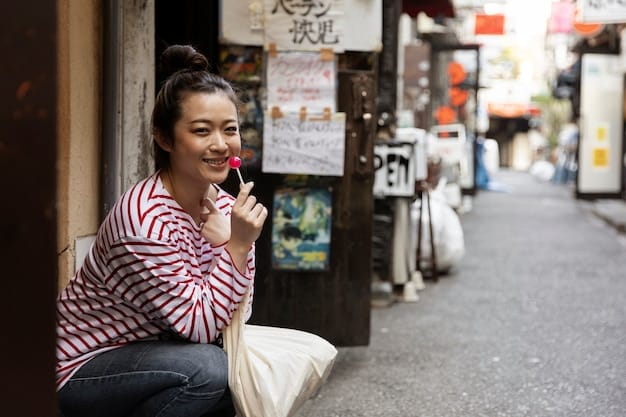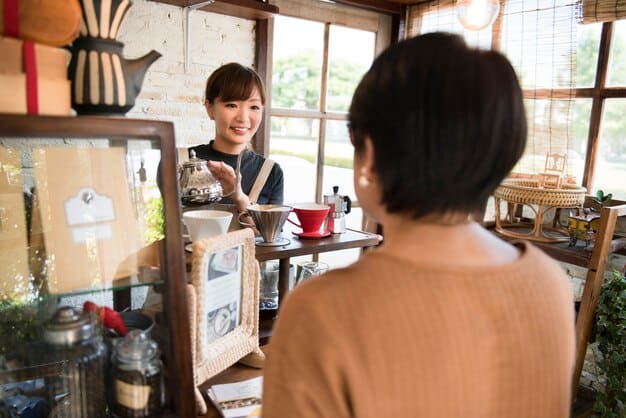Maximize Your Yen: US Tourists’ Guide to Japanese Souvenir Savings in 2025

Maximize Your Yen in 2025 by leveraging insider strategies, including tax-free shopping, favorable exchange rates, and discounts, allowing US tourists to potentially gain 10% more value on Japanese souvenirs.
Planning a trip to Japan in 2025 and dreaming of bringing back unique souvenirs? You can **maximize your yen: insider strategies for US tourists to get 10% more value on Japanese souvenirs in 2025** by using these tips and tricks. With a little planning and some savvy shopping strategies, you can stretch your dollar further and bring home even more treasured mementos of your Japanese adventure.
Understanding the Yen Exchange Rate for 2025
The exchange rate between the US dollar and the Japanese yen plays a crucial role in determining the value of your purchases. Understanding how these fluctuations can impact pricing, allows you to strategize your spending accordingly.
Here’s how to stay informed and potentially capitalize on favorable rates:
Tracking Exchange Rate Trends
Staying informed about exchange rate trends is essential if you want to make the most of your spending money while shopping in the Land of the Rising Sun. Before your trip, monitor the USD to JPY exchange rate.
Best Times to Exchange Currency
When is the best time to actually exchange your dollars to yen? Timing can influence how much “free money” you actually get.
- Monitor Market Opening Hours: Currency exchange rates can fluctuate throughout the day based on trading activity; so watching the markets is something to consider.
- Use a Limit Order: Limit orders allow you to set a specific exchange rate at which you want to buy yen. If the rate reaches your desired level, the transaction will automatically execute. This can be useful if you are trying to capitalize on a specific market condition.
- Consider Off-Peak Tourist Seasons: During off-peak tourist seasons, there may be less demand for yen, potentially giving you a better exchange rate. This might require a bit more research as you plan your trip.
Savvy currency exchange can significantly enhance your spending in Japan, allowing you to purchase more or save money. This knowledge is essential for anyone planning to enjoy shopping in Japan while maximizing their dollar.
Leveraging Tax-Free Shopping in Japan
One of the most effective strategies for US tourists to save money on souvenirs in Japan is taking advantage of the tax-free shopping system. Understanding eligibility requirements and what items qualify can lead to significant savings.
Here’s a breakdown of how to make the most of this beneficial system:
Eligibility for Tax-Free Shopping
Tax-free shopping in Japan helps to lower your expenses, but only certain people are eligible to participate in it.
Qualifying Items and Purchase Limits
Not all items qualify for tax-free shopping, and there are specific purchase limits that you should be aware of:
- General Goods: Items like clothing, accessories, bags, and crafts are eligible, but the total purchase must exceed ¥5,000 (approximately $35 USD) per store per day.
- Consumables: This includes food, drinks, cosmetics, medicines, and tobacco. These items must also total over ¥5,000 and must be consumed outside of Japan. They should be packed in a sealed bag provided by the store.
- Combining Purchases: Although rare, some stores allow the combination of general goods and consumables to reach the minimum spending requirement. Always confirm this with the store before finalizing your purchase.
Tax-free shopping in Japan is a valuable tool for US tourists looking to save money on souvenirs and other purchases. By understanding the rules and planning your shopping accordingly, you can significantly reduce your expenses and enjoy more of what Japan has to offer.
Finding Discounts and Special Offers
Beyond tax-free shopping, there are numerous discounts and special offers available to tourists in Japan that can further maximize your yen. Knowing where to look and how to obtain these savings is a valuable advantage.
Here are several strategies to help you find the best deals:
Tourist Discount Cards and Programs
Tourist discount cards and programs are specifically designed to offer savings for visitors. These cards can provide discounts on shopping, dining, attractions, and transportation.
Using Coupons and Apps
In today’s digital age, coupon apps and online deals are readily available. Here’s how to use them to your advantage in Japan:
- Japan Coupon Apps: Several apps specialize in offering coupons for tourists in Japan. Apps like Gurunavi and Hot Pepper Gourmet often feature discounts for restaurants, while other apps may offer deals for specific retailers.
- Hotel Loyalty Programs: Check if your hotel loyalty program offers any discounts or special offers in partnership with local businesses.
- Airline Partnerships: Some airlines partner with local businesses in Japan to offer exclusive discounts to their passengers. Check your airline’s website or app for potential savings.
Whether through tourist discount cards, strategic app usage, or seasonal sales, capitalizing on discounts and special offers can result in significant savings. Keep an eye out for these opportunities to make your souvenir shopping more affordable and enjoyable.
Shopping at Outlet Malls and Factory Stores
Outlet malls and factory stores in Japan offer an excellent opportunity to purchase high-quality items at discounted prices. These venues often feature brands with deep discounts, making them a smart choice for savvy shoppers.
Here’s what you need to know about finding the best deals at these locations:
Popular Outlet Malls in Japan
Japan boasts several outlet malls that are easily accessible and feature a wide variety of brands. Outlet malls concentrate several name brand stores in one location, but what are some of the more popular locales?
Tips for Navigating Outlet Malls
To make the most of your visit to an outlet mall, consider the following tips:
- Plan Your Visit: Check the outlet mall’s website for a directory of stores and any current promotions. Plan your route in advance to target the stores that interest you most.
- Visit During Off-Peak Hours: Outlet malls can get crowded, especially on weekends and holidays. Try to visit during weekdays or early mornings to avoid the crowds and have a more relaxed shopping experience.
- Check for Additional Discounts: Inquire at the information desk about any additional discounts for tourists or special promotions that may not be advertised.
- Pay Attention to Quality: While outlet stores offer great deals, be sure to check the quality of the items. Some items may be slightly flawed or from previous seasons, so inspect them carefully before making a purchase.
Shopping at outlet malls and factory stores in Japan is a strategic way to acquire quality souvenirs and gifts at reduced prices. With a bit of planning and savvy shopping habits, you can find amazing deals without compromising on quality or style.
Bargaining and Negotiation Strategies
While bargaining isn’t as common in Japan as in some other countries, there are still situations where negotiation is acceptable, particularly in smaller, independent shops and markets. Knowing when and how to negotiate can potentially save you money.
Here’s how to approach bargaining respectfully and effectively:
When to Negotiate
Bargaining or negotiating is more accepted in certain locations versus others, so keep this in mind while shopping.
Effective Negotiation Techniques
Even when you are able to negotiate, do so with respect as the Japanese do not take to any form of disrespect lightly. Here are a few strategies:
- Be Polite and Respectful: Always approach negotiations with a courteous demeanor. Politeness is highly valued in Japanese culture, and starting on a positive note can make the other party more receptive.
- Start with a Reasonable Offer: Research the average price of the item beforehand to make a reasonable initial offer. Undervaluing the item can be offensive, while overpaying defeats the purpose of bargaining.
- Ask for a Discount: Instead of directly lowering the price yourself, ask the seller if there are any discounts available. You could say, “Is there any discount available for this item?”

While bargaining requires a sensitive approach in Japan, understanding when and how to negotiate can result in savings, especially in local markets and independent shops. By being respectful, informed, and patient, you can navigate these interactions successfully.
Utilizing Credit Cards and Payment Apps Wisely
Choosing the right payment method can significantly impact your overall spending, especially when it comes to exchange rates and fees. Credit cards and payment apps offer different advantages, but it’s essential to use them wisely to avoid unnecessary costs.
Here’s what you need to know about using credit cards and payment apps in Japan:
Best Credit Cards for International Travel
Selecting the right credit card for international travel can save you money on fees and offer additional benefits. When choosing a credit card for your trip to Japan, consider the fees, any rewards, and acceptance locations.
Using Payment Apps and Mobile Wallets
Mobile payment options have become increasingly popular, but their acceptance in Japan can vary.
- Suica and Pasmo: These are rechargeable contactless cards primarily used for public transportation but also accepted at many convenience stores, vending machines, and shops. Using them can streamline small purchases, but they don’t offer significant savings.
- Apple Pay and Google Pay: While these are becoming more common, acceptance is limited compared to the US. Check with individual stores to see if they accept these forms of payment.
- QR Code Payments (PayPay, Line Pay, Rakuten Pay): These are widely used by locals but typically require a Japanese bank account or phone number to set up.
By carefully selecting your credit cards, understanding the exchange rates, and knowing the acceptance rates of different payment apps, you can manage your spending more effectively and avoid unnecessary costs while shopping in Japan.
| Key Strategy | Brief Description |
|---|---|
| 💰 Tax-Free Shopping | Shop at stores offering tax refunds for tourists with purchases above ¥5,000. |
| 💹 Favorable Exchange | Monitor the USD to JPY exchange rate and exchange currency when the rate is favorable. |
| 🛍️ Outlet Malls | Visit outlet malls for discounted prices on brand-name items. |
| 🎫 Tourist Discounts | Utilize tourist discount cards and programs for savings on attractions and shopping. |
Frequently Asked Questions
Tax-free shopping allows foreign tourists to purchase goods without paying consumption tax (10%). To be eligible, purchases must exceed ¥5,000 (about $35 USD) at participating stores.
Look for tourist discount cards, use coupon apps like Gurunavi, and check for seasonal sales. Some hotels and airlines also offer partnerships with local businesses for discounts.
Bargaining is not widespread but is acceptable in smaller, independent shops and markets. Always negotiate politely and start with a reasonable offer, avoiding being disrespectful.
Opt for credit cards with no foreign transaction fees and good exchange rates. Cards that offer travel rewards or cash back on purchases are also beneficial.
While widely used by locals, most apps require a Japanese bank account. Suica and Pasmo cards for transportation are commonly accepted at stores. Acceptance of Apple Pay and Google Pay is still limited, so check ahead of time.
Conclusion
By leveraging these strategies, US tourists can maximize their yen and enjoy a more rewarding souvenir shopping experience in Japan. From understanding exchange rates to utilizing tax-free shopping and finding the right payment methods, these insider tips will help you stretch your dollar and bring home cherished memories without breaking the bank.





